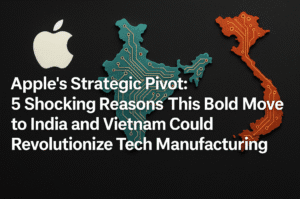Apple’s Strategic Pivot: 5 Shocking Reasons This Bold Move to India and Vietnam Could Revolutionize Tech Manufacturing
Apple is shifting most U.S.-bound iPhone production from China to India, while Vietnam will manufacture iPads, Macs, and wearables, marking a strategic pivot to mitigate tariff risks and geopolitical pressures. The move responds to escalating U.S.-China trade tensions, with Apple estimating $900 million in potential tariff costs this quarter, despite exemptions for key electronics. India’s cost-efficient labor, government incentives, and growing market appeal make it a critical hub, while Vietnam’s established tech infrastructure supports diversification.
This transition, part of Apple’s broader $500 billion U.S. investment plan, aims to align with political demands for reduced reliance on Chinese manufacturing. However, replicating China’s intricate supplier ecosystem poses challenges, requiring significant time and investment. For consumers, pricing may remain stable as Apple absorbs costs, but global supply chains will split: non-U.S. markets still depend on Chinese production. The shift signals a broader industry trend toward supply chain resilience, reshaping regional economies and challenging China’s dominance.
Apple’s gamble underscores the complex balance of geopolitics, cost, and quality in a fractured trade landscape.

Apple’s Strategic Pivot: 5 Shocking Reasons This Bold Move to India and Vietnam Could Revolutionize Tech Manufacturing
In a bold response to evolving trade dynamics, Apple has announced a significant shift in its production strategy, moving most U.S.-bound iPhone manufacturing from China to India, while Vietnam takes the helm for iPads, Macs, and wearables. This recalibration, driven by geopolitical pressures and tariff uncertainties, signals a new era for global tech supply chains. Here’s a deep dive into the implications of this move and what it means for consumers, investors, and the broader industry.
Why India and Vietnam?
Apple’s pivot to India and Vietnam isn’t merely about dodging tariffs—it’s a calculated diversification play. India, with its massive labor force and government incentives like the Production-Linked Incentive (PLI) scheme, offers cost efficiencies and a growing consumer market. Vietnam, already a hub for Samsung and other tech giants, provides established infrastructure and favorable trade agreements. Both countries mitigate risks tied to U.S.-China tensions, which have escalated under recent administrations.
The Tariff Trigger
Former President Donald Trump’s tariffs on Chinese imports, aimed at reshoring manufacturing, pushed Apple to rethink its reliance on China. While the Biden administration exempted some electronics, uncertainty lingers. Apple estimates tariffs could still add $900 million to costs this quarter. By shifting U.S.-bound production, Apple hedges against future trade disruptions and aligns with political calls for “Made in America” sourcing—even if assembly occurs abroad.
Investment and Challenges
Transitioning production requires monumental investment. Apple plans to inject $500 billion into U.S. operations over four years, spanning R&D, data centers, and retail. Yet, building robust supply chains in India and Vietnam won’t be seamless. Challenges include:
- Supply Chain Complexity: Replicating China’s ecosystem of suppliers and skilled labor takes time.
- Quality Control: Ensuring product standards amid rapid scaling.
- Cultural Adaptation: Navigating local regulations and workforce dynamics.
Analyst Patrick Moorhead notes Apple’s progress is “impressive,” considering past claims that only China could produce iPhones. However, Shanti Kelemen of M&G Wealth cautions that relocation costs and lingering tariffs could pressure margins.
Broader Market Ripples
Apple’s shift mirrors trends across industries. Amazon, for instance, reports adapting to tariffs by diversifying suppliers and leveraging scale. While neither company has seen significant sales dips yet, both emphasize agility in a volatile trade landscape.
For consumers, the immediate impact may be muted. iPhones sold in the U.S. might not see price hikes if Apple absorbs costs or benefits from cheaper labor. However, non-U.S. markets will still rely on Chinese production, creating a bifurcated supply chain.
Geopolitical and Economic Implications
This move underscores a strategic decoupling from China, driven by both policy and pandemic-era supply chain lessons. India and Vietnam stand to gain jobs and tech sector growth, potentially reshaping regional economies. Meanwhile, China retains dominance in non-U.S. markets, but its role as the “world’s factory” faces erosion.
Looking Ahead
Apple’s transition is a bellwether for global manufacturing. Success hinges on balancing cost, quality, and speed—all while navigating geopolitical headwinds. For the U.S., Apple’s investments may bolster tech innovation but won’t immediately revive manufacturing jobs, highlighting the complexity of modern supply chains.
As trade policies evolve, Apple’s gamble on India and Vietnam could inspire peers to follow suit, accelerating a redistribution of global production hubs. The stakes are high, but the payoff—a resilient, diversified supply chain—could redefine tech manufacturing for decades.
You must be logged in to post a comment.